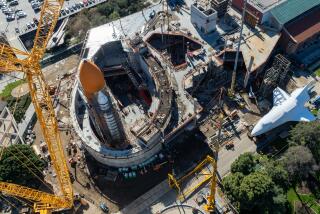Shuttle Crew Completes Link No. 1
- Share via
HOUSTON — After successfully joining and outfitting the first two pieces of the international space station, Endeavour’s astronauts set the seven-story complex loose Sunday and flew away.
They were sorry to go but were pleased to leave behind “the brightest new star on the horizon.”
“Wish we could stay longer,” commander Robert Cabana said, “but we’ll get safely away and leave it for somebody else to come back and add more to it.”
It will be spring before the next construction crew arrives.
With the flick of a switch that released the snares holding them together, space shuttle Endeavour separated from the 77-foot, 70,000-pound station and, with pilot Rick Sturckow at the controls, slowly backed away.
Flight controllers in Houston and Moscow monitored the 245-mile-high action. The undocking, similar to those between space shuttles and Mir, occurred over Russian ground stations.
The winged, cylindrical station glistened in the sunlight as the shuttle circled from a distance of 450 feet for a final photo survey. Once that was done, Sturckow fired Endeavour’s thrusters and the shuttle pulled away.
The astronauts could still see the station from more than eight miles.
“It’s the brightest new star on the horizon,” Cabana said as the station grew smaller.
With Endeavour’s flawless departure, NASA’s lead flight director, Bob Castle, was finally ready to declare the assembly portion of the 12-day mission a success.
“I’m very, very, very gratified,” Castle said.
The undocking capped an intense week for Endeavour’s six astronauts, who are due back on Earth late Tuesday.
They captured Zarya, the Russian-built control module, and stacked it on the American-made Unity chamber in the shuttle cargo bay on Dec. 6, then conducted three spacewalks to wire the components together, install and fix antennas and attach a toolbox to the outside. They also spent a full day inside the station, sprucing it up for the first permanent crew, due to arrive in just over a year.
Working quickly, they accomplished everything they set out to do and more.
“This has been a truly awesome experience,” Cabana said. “. . . This is going to be one heck of a space station when we get it done.”
NASA plans four shuttle flights to the space station next year, starting in May, to haul up more equipment. Ten spacewalks will be conducted during those missions to attach more parts.
The work should crank up in 2000 and stay at a feverish pace until the last major component is launched to the station in 2004.
Much depends on the Russian Space Agency, broke as a result of Russia’s economic collapse. NASA has forked over an extra $60 million to its leading partner in recent months in hopes of having a permanent control module flying by the end of next summer, more than a year late.
Just in case, the National Aeronautics and Space Administration is working on substitute modules.
More to Read
Sign up for Essential California
The most important California stories and recommendations in your inbox every morning.
You may occasionally receive promotional content from the Los Angeles Times.












